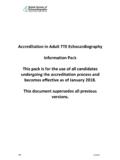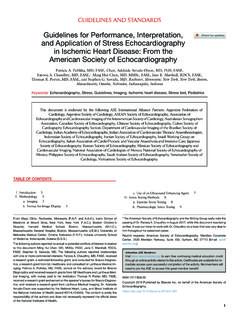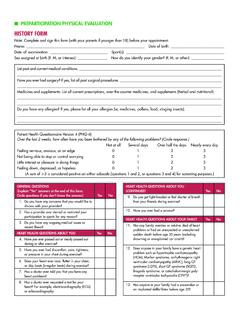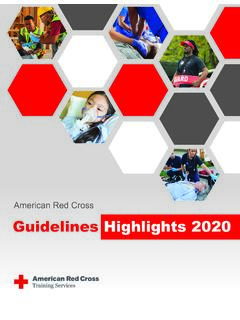Transcription of The Echocardiographic Assessment of the Right Ventricle ...
1 The Echocardiographic Assessment of the Right Ventricle with particular reference toArrhythmogenic Right Ventricular Cardiomyopathy A Protocol of the British society ofEchocardiographyLead AuthorsDr. David Oxborough, Dr Abbas Zaidi, Prof Sanjay Sharma, Prof John SomaurooEducation Committee AuthorsDr Rick Steeds (Chair), Will Bradlow, Alison Carr, Richard Jones, Prathap Kanagala, Daniel Knight, Guy Lloyd, Thomas Mathew, Navroz Masani, Kevin O Gallagher, Bushra Rana, Liam Ring, Julie Sandoval, Martin Stout, Gill Wharton, Richard WheelerPreambleAssessment of the Right Ventricle (RV)
2 Is often challenging and sometimes overlooked, however recent guideline documentation from the american society of echocardiography suggested a measure of RV structure and function should be mandatory in all clinical reports*. The BSE advocates RV Assessment within the minimum dataset; however in certain conditions such as arrhythmogenic Right ventricular cardiomyopathy (ARVC), pulmonary hypertension, pulmonary embolism, RV myocardial infarction and athletic heart syndrome a more comprehensive Assessment of the RV is required.
3 RV Assessment can be described in terms of RV dimensions, structure and function and the Assessment of ARVC utilises this approach. It is clear that with other RV pathology the measurements are similar but their interpretation should be taken in the clinical is one of the most common and under-diagnosed causes of cardiac sudden death in a young person and therefore an appropriate diagnosis is crucial. echocardiography has variable sensitivity and specificity for the diagnosis of ARVC and therefore only forms a small part of the complete diagnosis.
4 Corroborative investigations are key and include a comprehensive history, clinical examination, electrocardiogram, magnetic resonance imaging and genetic testing all contributing to the overall Assessment . Echocardiographic criteria demonstrated in isolation should be interpreted with caution and therefore although this document is a protocol for RV Assessment per se, it should be used only as part of the Assessment for 1- Echocardiographic criteria for ARVC (adapted from Marcus et al 2010)MAJOR Echocardiographic CRITERIA FOR ARVCR egional RV Dyskinesia or AneurysmAnd one of the followingPLAX RVOT 32mm (corrected for body size [PLAX/BSA] 19mm/m2)PSAX RVOT 36mm (corrected for body size [PLAX/BSA] 21mm/m2)
5 OrFractional Area Change 33%MINOR Echocardiographic CRITERIA FOR ARVCR egional RV Akinesia or DyskinesiaAnd one of the followingPLAX RVOT 29 to < 32mm (corrected for body size [PLAX/BSA] 16 to < 19mm/m2)PSAX RVOT 32 to < 36mm (corrected for body size [PLAX/BSA] 18 to 21mm/m2)OrFractional Area Change > 33 to < 40%MeasurementsRVOTPLAXQ ualitative regionalwall motion analysis ofthe anterior wall of theRV Qualitative regionalwall motion analysis ofthe anterior and inferi-or walls of the RVAssess the severity oftricuspid regurgita-tionand estimate RVsystolic pressure(for details see pul-monary hypertensiondataset)Proximal RVOT (RVOT1)Qualitative assessmentof RV structure andfunctionRegional wall motionanalysis of the outflowtract of the RV(infundibulum)
6 Explanatory note for ARVC-end diastole*-adjust depth and focal zone to consistency, ideally, this measurementshould be taken at a similar level to RVOT1measurement of PSAX AV view. HenceRVOTPLAX should be a measurement perpen-dicular line from the RV anterior wall to thelevel of the aortic 2D measurements should be blood tis-sue interface to blood tissue interfaceRVOTPLAX 32mm or 19mm/m2 AND thepresence of regional RV akinesia, dyskinesiaor aneurysm is a major criterion**RVOTPLAX 29mm to < 32mm OR 16mm/m2to <19mm/m2 AND the presenceof regional RV akinesia or dyskinesia is aminor criterion**-ensure the ventricular septum has beenexcluded and the true inferior wall is seen(diaphragm and liver in view)
7 The presence of TR is not a sensitive or spe-cific finding for ARVC however severe func-tional TR may occur in the presence of RVdilatation and dysfunction-at end diastole*-measured from anterior aortic wall directlyup to the RV free wall (at the level of theaortic valve)-the PSAX view has been shown to be morereproducible than the measurementobtained from the PLAX orientationRVOT1 36mm or 21mm/m2in the pres-ence of regional RV akinesia, dyskinesia oraneurysm is a major criterion**Modality2D2 DColourFlowDopplerCWDoppler2 DVIEWPLAXPLAX RVinflowPLAX RVinflowPSAX AV levelImageDistal RVOT (RVOT2)
8 Qualitative assessmentof RV structure andfunctionRegional wall motionanalysis of theinfundibulum of the RVPA diameter Qualitative assessmentof RV structure andfunction at basal levelRegional wall motionanalysis of inferior, lat-eral, anterior and sep-tal walls of RV in PSAXat base (mitral valve)levelQualitative assessmentof RV structure andfunction at papillarymuscle levelRegional wall motionanalysis of inferior, lat-eral, anterior and sep-tal walls of RV in PSAXat mid (papillary mus-cle) levelQualitative assessmentof RV structure andfunction at the apexRegional wall motionanalysis of inferior, lat-eral and septal walls ofRV in PSAX at apexlevelRVOT1 32mm to < 36mm or 18mm/m2to <21mm/m2in the presence of regionalRV akinesia or dyskinesia is a minor criteri-on**-end diastole*-measured just proximal to PVThere are no specific values for diagnosis ofARVC however this should be used todemonstrate > 27mm is abnormal in other cardiacpathology*-end diastole- half way between pulmonary valve (PV)
9 And bifurcation of main PA or 1cm distal toPV Enlargement of the pulmonary artery makesthe diagnosis of ARVC less likely (may beindicative of conditions causing pulmonaryhypertension)Relative size of RV to LV should be assessed There is disproportionate enlargement of theRV in ARVCR elative size of RV to LV should be assessedRelative size of RV to LV should be assessed 2D2D2 DPSAX PV levelPSAX BasePSAX MidPSAX ApexRVD1 Basal RVdiameter (end diastoleat the maximal valuewithin the first third ofthe RV)*RVD2 Mid RV diame-ter (end diastole in themiddle third of the RVat the level of the LVpapillary muscles)RVD3 RV length (enddiastole from tricuspidannulus to the RVapex)Fractional AreaChange (FAC )Qualitative assessmentof RV structure andlongitudinal functionTricuspid PlaneSystolic Excursion(TAPSE) E and A wave peakvelocitiesfor RV dias-tolic function usingtrans-tricuspid PWDoppler (optional)Systolic (S ), early(E ) and atrial (A )relaxationvelocitiesat lateral TV annulusFocused RV 4CH viewis obtained byensuring :1.
10 True apex is visualised, with scan plane posi-tioned through the LV in the centre of the cavity2. RV is not foreshortened and LVOT is notopened3. largest RV dimensions are optimised whilemaintaining on axis view, as described above(for further clarification see ASE RV guidelines*) There are no specific values for diagnosis ofARVC however all RV measurements should beused to demonstrate dilatation. RVD1> 42mm,RVD2> 35mm and RVD3> 86mm are abnor-mal*-trace around the endocardium of the RV lateralwall at end diastole and end not trace around individual trabeculations,which should be included within the cavityarea.








